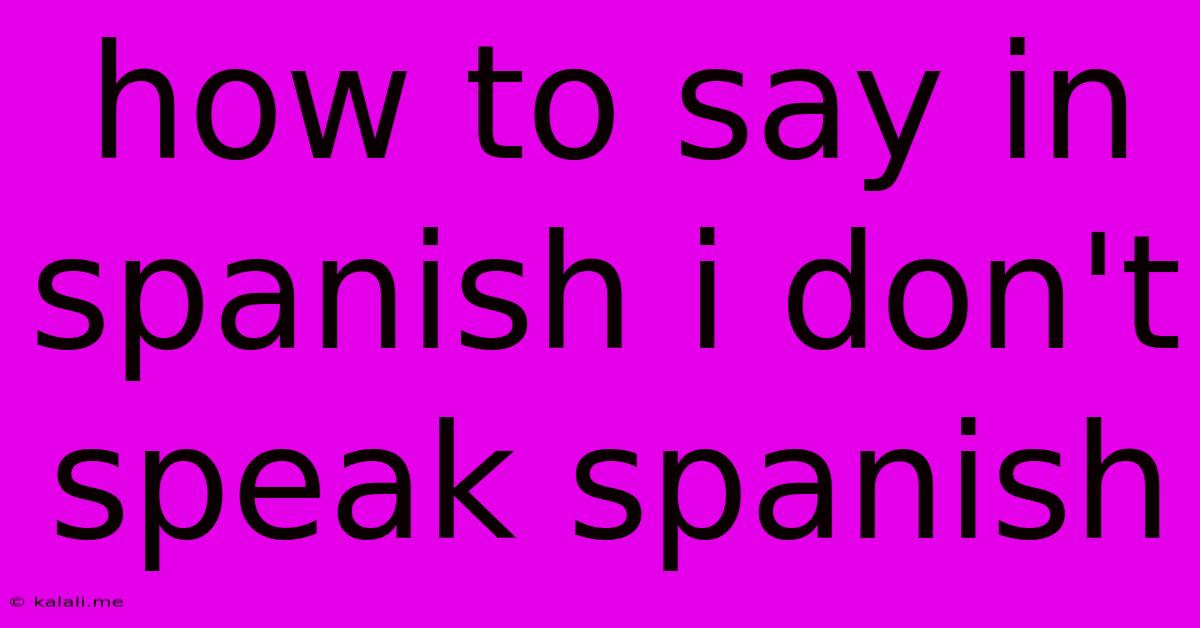How To Say In Spanish I Don't Speak Spanish
Kalali
May 22, 2025 · 3 min read

Table of Contents
How to Say "I Don't Speak Spanish" in Spanish (and Other Useful Phrases)
So, you're in a Spanish-speaking country and you need to let someone know you don't speak the language. This seemingly simple task can be surprisingly tricky, especially if you're unsure of the best way to phrase it. This article will guide you through several options, ranging from formal to informal, and offer some helpful tips for navigating these situations. Knowing how to express this effectively will help you avoid misunderstandings and make your interactions smoother.
The Most Common Phrase: "No hablo español."
The most straightforward and widely understood way to say "I don't speak Spanish" is "No hablo español." This is a grammatically correct and perfectly acceptable phrase in most situations. It's clear, concise, and easily understood by native Spanish speakers.
- No: No
- hablo: I speak
- español: Spanish
More Polite Options:
While "No hablo español" is perfectly fine, adding a bit of politeness can go a long way. Here are a few alternatives:
-
"No entiendo español." This translates to "I don't understand Spanish." This is a good option if you catch a few words but can't fully grasp the conversation. It subtly conveys that you're making an effort to listen.
-
"Habla usted inglés?" This means "Do you speak English?" This is a proactive approach, shifting the focus to finding a common language. It's especially helpful if you're more comfortable communicating in English.
-
"Perdón, no hablo español." This adds "Excuse me" to the original phrase, making it more polite. Using "Perdón" shows respect and acknowledges any inconvenience caused by your lack of Spanish proficiency.
Adding Context and Gestures:
Sometimes, just saying the phrase isn't enough. You can enhance your communication by:
- Using gestures: Pointing to yourself and then shrugging your shoulders can visually reinforce your message.
- Using a translation app: Showing the phrase on your phone can be a helpful visual aid.
- Smiling and being patient: A friendly demeanor can make a big difference in how people react to your language barrier.
What to Do After Saying "I Don't Speak Spanish"
Once you've communicated your lack of Spanish fluency, here are some things you can do:
- Try to identify someone who speaks English or your native language.
- Use a translation app.
- Use simple gestures and point to what you need.
- Be patient and try to communicate through non-verbal cues.
Learning a few basic Spanish phrases, even simple greetings like "Hola" (hello) and "Gracias" (thank you), can also be incredibly helpful and demonstrate a willingness to engage with the local culture.
Conclusion:
Knowing how to say "I don't speak Spanish" in Spanish is a valuable skill for any traveler or individual interacting with Spanish-speaking communities. While "No hablo español" is the most common and effective phrase, remember the importance of politeness and context. By combining verbal communication with gestures and a friendly attitude, you can successfully navigate language barriers and ensure positive interactions. Remember to be patient and appreciate the effort others make to communicate with you.
Latest Posts
Latest Posts
-
Radiation Can Pass Through Transparent Surfaces Such As Glass
May 22, 2025
-
Air Conditioning In Car Smells Bad
May 22, 2025
-
Ticking Sound From Engine When Idle
May 22, 2025
-
How Long Did The Plagues Last In Egypt
May 22, 2025
-
Can You Freeze A Can Of Beer
May 22, 2025
Related Post
Thank you for visiting our website which covers about How To Say In Spanish I Don't Speak Spanish . We hope the information provided has been useful to you. Feel free to contact us if you have any questions or need further assistance. See you next time and don't miss to bookmark.